- The first part introduces the conceptual sketch, pencil study and color study as well as how the oil painting evolved over major revisions to arrive at its final state.
- The second part details the study and creation of key characters in the painting. It also includes reference pictures I took when I went on a field trip to Fujian in Southern China where early Taiwanese immigrants came from.
「先民渡海——抵岸」的創作過程
以下分兩個部份,以圖、文並列方式對「先民渡海——抵岸」創作過程作了眞實呈現。這篇文章介紹構思小草圖、素描稿、油畫色彩稿及大幅度更改油畫構思、人物結構後各種衍變的情形。
下一篇文章則是對畫中主要人物形象探索過程的剖析。最後,附上閩南行的一些生活照和有關素材資料照片。
Composition
The tenacity of the Taiwanese people inspired me to work on the historical subject of Taiwan’s Forefathers. When I first arrived in Taiwan in 1985, I saw a vegetable farmer working in the rain on the outskirts of Caozhou, a housewife minding a general store in Fengcheng St. late into the night, metal workers working through the night at a factory in Taipei at the intersection of Sanmin Road… There were just so many examples. The feeling was there but the actual inspiration for the painting came from a chance conversation with a friend at an art gallery. When I heard about how the forefathers came to Taiwan by boat and everyone knew the story of “Crossing from Tangshan to Taiwan”, I knew that this would make a great subject for a painting. I could see the imagery in my head and the potential for artistic interpretation. I went to the bookshops to look for related references, and my most exciting find was the book A Tragic Ballad About Hakka Sailing to Taiwan by Mr. Jung-lo Huang. A hand-written copy of the Hakka folk song discovered by Huang in 1986 recounted more than three centuries of migration to Taiwan. The convincing and detailed account of the many tragedies they suffered moves the readers to tears.
構思, 草圖
關於先民渡海這一歷史題材的創作,思想底層緣起於台灣人民普偏展現的那種打拼奮精神的感動,七、八年前初來台時,見到潮州城郊冒雨作業的菜農,楓城街邊深夜還未打烊的小雜貨店主婦,台北三民路口那徹夜趕工的鐵工廠工人們等等……好多好多。感受是具體的,但是想要作畫則是後來在畫廊朋友閒談中聽到有關先民渡海來台,人人皆熟的「唐山過台灣」的史跡,使我意識到這裏有畫面,有藝術想象力發揮的天地,是作畫的好題材。於是我專門去書店搜尋有關史料,其中令我最興奮的是黃榮洛先生所著「渡台悲歌」一書,黃先生於1986年發現客族的「渡台悲歌」手抄本,它眞實而生動地記敍了三百多年來先民渡台的種種悲慘的遭遇和歷史,內容詳盡,有情有淚。
I started working on the composition and completed Reaching Shore first sketch in June 1991. The sketch depicted the forefathers wading ashore from a sampan after braving the waves to cross the “Black Trench” of the Taiwan Strait. During the early Qing Dynasty, the imperial government imposed strict bans on all sea travel to Taiwan to prevent any resurgence in support for Koxinga who supported the old Ming Dynasty. The early migrants to Taiwan were mostly poor people risking death to seek a new life in Taiwan. I decided to emphasize the determination, courage and fearlessness of the forefathers rather than focusing too much on their suffering or their weakness after their stormy crossing. In October, I made a small sketch of the migrants battling storm waves during the crossing. In this way, I was able to present the two key elements of the “Crossing” theme. Interestingly, I placed a sampan on the deck of the ship in my first draft for Crossing the Stormy Strait. When I visited the Quanzhou Mazu Temple in Fujian the following year, a model of the ship used for strait crossings showed a sampan on the deck as well. The old man looking after the temple told me that sampans were carried on deck instead of towed from the stern during crossings because they were easily damaged by the heavy seas. I was quite delighted by this discovery.
接著,我開始畫構思小草圖,1991年六月先畫了「抵岸」。描繪先民們歷盡風浪,越過海峽「黑水溝」、由舢板接送灘邊,涉灘上岸的情景。清代早期,清庭爲防明鄭勢力復起,頒佈嚴苛禁令,嚴禁出海渡台。渡台移民者多爲社會底層窮苦百姓,爲求生存,求開拓,仍然連年不絕地冒死來台,所以,我決定表現先民們堅毅、勇敢、不畏難的精神特質,而不過份渲染苦難及歷經風浪後的衰弱景況。到十月份,再畫了渡海時與險風惡浪博鬥的場面的小草圖,如此才可以較全面地表現渡海這一主題的兩個重要方面。很有意思的是,我在「海峽夜浪」的第一草圖中,在大船上就擱置了舢板,第二年去福建泉州媽祖廟看到渡海船模型時,駭然發現也有舢板置於大船上,管理廟的老伯告訴我是因爲渡海風浪大,怕舢板拖在大船尾容易被打壞之故,這一發現令我驚喜不已。
Charcoal study
In 1992, I went to Southern Fujian Province for a research trip over the course of April and May. I traveled through Xiamen, Quanzhou, Zhangzhou, Dongshan Island, farming villages in Pinghe County, Shenhu Harbor, Jinjiang, Hui’an, and Meizhou Island carrying my oil painting box, canvas, sketch book and camera. I painted fishermen and farmers, visited a number of Mazu temples, and collected reference photos for character images, shipping, props, and clothing. I also held a number of talks with painters, teachers and students from the Department of Fine Arts at Xiamen University, Xiamen Artist Association, the Department of Fine Arts at JiMei Normal School, and Quanzhou Artist Association. They provided me with advice and assistance. Once I returned to Taipei, I began working on the large drawing study for Reaching Shore.
素描稿
1992年四、五月赴閩南考察搜集素材,背了油畫箱,帶了畫布和速寫本、相機,先後去了廈門、泉州、漳州、東山島、平和縣農村、深滬港、晉江、惠安、湄州島。畫漁民、農民,參觀了多處馬祖廟,收集了人物形象、船舶、道具、服裝等相關圖片資料,還與廈大美術系、廈門美協、集美師範美術系、泉州美協等單位的畫家、師生座談,並得到他們的建議和幫助。回到台北後即開始畫「抵岸」的大素描稿工作。
The tone set by the drawing was the joy of hope with a touch of gallantry. A child holding a Mazu idol was made the center of the painting while a farmer with a hoe over his shoulder and a machete on his waist was made the main character. Other characters were progressively developed from there. After much thought, the bent-over man carrying a box on his back was changed to a craftsman carrying a wooden crate. The young man at the front to be playing a simple farmer’s banhu was something that I had planned all along. The fragile old man, the woman with her belongings on top of her hand, the young girl, the boatman, the sampan, the ship, the waves, the farmer in his prime… these all gradually took shape after much thought. I even added a peasant woman with shoulder poles to give the characters more depth. What I did not expect was this character eventually becoming one of the key figures in the composition.
素描稿確立的主調是看到希望的喜悅,甚至有些豪邁之氣,也確立了以小孩懷抱的馬祖像爲畫面中心,以肩扛鋤頭、腰跨柴刀的農民爲主角,逐一展開其他人物,經反覆琢磨,將彎腰揹箱的男子改爲揹木箱的工匠,走在前頭的青年則早就設想他帶着農村簡易的板胡,體弱的老人,頭頂包袱的女人,年青姑娘、船伕、舢舨、大船、海浪、青壯年農民,都在反覆推敲中明晰出來,後來還添加挑擔的農婦,以增加人物的縱深感,想不到這位側面的人物,最後發展成爲面向我們而居畫面主要代表人物之一。
Much of this drawing was taken up by the sky. I originally intended to highlight the freedom of the “new world” and the characters would have a darker palette so they stood out against the sky and the ground. Big changes were made to this idea resulting in the final composition.
此稿天空面積頗大,初時想法是突出「新天地」,帶來一種海闊天空的氣概,人物色調深重,突出於天空之間,現在完成的畫面則是對這一構思作出重大修改的結果。
The drawing was made using charcoal sticks on standard student-grade oil painting canvas to make erasing and revisions easy.
素描稿材料是用一般學生用油畫布,以炭條作畫,便於搽拭修改。
Color study
A large original oil painting with numerous characters must go through a number of color studies. I ended up making three color studies in all.
油畫色彩稿
對於大幅衆多人物畫創作,色彩小稿、色彩稿是必需之階段,爲此,我先後作了三幅油畫色彩稿。
The small color study in 1992 had cool tones and the red of the Mazu idol’s decorations really stood out in the painting. I was quite satisfied with the overall arrangement of the colors and it was a pleasure to paint. The color study went to a collector friend and I miss it terribly!
1992年的小稿是冷調子,媽祖像以紅色飾物爲全畫突出之色彩,整個色彩配置頗感滿意。畫得也渾厚輕鬆,一位收藏畫的朋友執意要我讓給她,早把錢付定了,寫這幾句話時,畫就在我旁邊,眞是捨不得啊!
When I was working on the large color study in 1993, I went for warmer tones to create a contrast with the cool tones of Crossing the Stormy Strait. This was the reason why the second and third color studies leaned towards warm tones.
九三年,畫大色彩稿時,考慮到與「海峽夜浪」的冷色調形成對比,就往暖調子靠,這就是第二、第三稿偏暖的原因。
The origin of the third color study was a story in itself. The collector Mr. Ping-kun Hung wanted to add one of my still life paintings of a fish to his collection. When he came to my studio and saw the large color study, he changed his mind and wanted me to paint Taiwan’s Forefathers – Reaching Shore in canvas size 30 for him first. I had intended to revisit the color relationships of the second color study, so this became the third color study. A limited-edition print of this draft in its true size was produced as well. The main difference from the second draft was the thumb-sized heads, the use of texture on the characters, as well as same coarse canvas weave as used for the large painting.
第三稿的由來有個小故事,收藏家洪炳焜先生要收藏我一幅靜物魚,來到畫室看到正進行的「渡海」大畫,改變心意,要我先畫幅30號「先民渡海——抵岸」給他,我也有意再探索二稿的色彩關係,遂是有了第三稿,並且印刷了此稿的等大有限複製畫,此稿與二稿有不同是在拇指大的頭部還有見筆觸的人物刻劃,也彩取與大畫同檥的粗紋畫布。
Major revisions to the oil painting
In 1993 I began transferring the outlines of the characters from the large drawing study to the three-meter high large canvas. Here I used the traditional grid method for proportional scaling. Color was then applied for the first time with my students serving as models for verifying poses. In the spring of 1994, I went to New Zealand for a plein-air painting trip. Once I finished the paintings for the New Zealand exhibition, I went back to working on the painting again. At this point, I started feeling uneasy about the overall atmosphere of the original painting. One night, the television producer Mr. Xiao-pei Yu invited me to have dinner with him. Over drinks, he came right out and said that there wasn’t enough suffering in this painting. He also wondered if it was still influenced by my old work back in Mainland China? It was like an epiphany to me. I wasn’t drunk yet so I knew that he had identified the source of my unease. Though his opinion was rather vague, I felt that he was on the right track. I raised my glass to him, thanked him, said that I will work hard to overcome this deficiency, then downed the glass in one go! This would be the start of another long and difficult journey.
大畫變動過程
1993年開始將大素描稿的人物輪廓移置到三米的大畫布上去,我採用了按比例打格放大的傳統方法。跟著上了第一遍顏色,請了我的學生充當模特兒核對動作。94年春去紐西蘭寫生,將紐西蘭主題展的畫完成之後又轉入「渡海」之途。這時,對於原畫呈現的大氣氛有所不安。某晚,影視製作人兪曉佩先生請我吃飯,酒酣耳熱之際,他直這此畫尙不夠苦難感,是否還有過去大陸藝術創作的影響在?當場,眞有如天雷轟頂,我還未醉,知道這句話指出了我之所以不安的徵結所在,意見雖不具體,但感覺是對的,當時我向他高舉酒杯,謝他,他造訴他我會努力克服此項缺失,言畢,一飲而盡!此後,我就進入另一段苦鬥的歷程。
It proved a long and sleepless night. I thought about many things and straightened them out in my mind. My biggest issue was the emphasizing of heroic characters due to past Soviet and Mainland influences. The forefathers weren’t someone extraordinary like Napoleon or farmers in revolt so the heroic pose of the man carrying the hoe looked out of place in the composition. The overall atmosphere was just a little too joyful and there was not enough suffering. Once I wrapped my head around that, the entire composition felt wrong. I wanted to get rid of the mighty “hero” in particular right away. As I couldn’t sleep, I decided to do some sketches. I immediately made two small studies and spent the entire day next day making rough changes to the full painting. I feared that I might change my mind otherwise. By bulldozing the changes through as quickly as possible, I made backtracking altogether impossible. It was a hack job, but my whole approach changed. I am really grateful to this friend I didn’t know well for his honest words. I must also thank my mother for teaching me to be a humble person that listens to other people because it is how I grow and improve.
那晚回來之後久久不能入睡,想了很多問題, 清理了自己的思想,主要是還有蘇聯和大陸過去那種突出主要英雄人物的影響存在,今天面對的先民群衆不是拿破崙,也不是農民起義,因而畫面中那荷鋤男子英雄式的形態就有些不自然,另外,整個氣氛太突出高興的一面,那種苦難感覺就不夠了。思想一轉變之後,看著畫面反而有種格格不入之感,尤其對那氣宇軒昂的「主角」,想馬上去之而後快。既然睡不著就來畫草圖,當下畫了兩幅小草圖,第二天整天就將全畫草草改畫了,不如此,我還眞怕動搖,只有盡快徹底推翻,讓自己搖無可搖。我知道這是粗糙的。但畢竟改觀了。眞要感謝這素昧平生的朋友眞言,感謝母親從小教導我要謙虛聽取別人意見,才能使自己進步、獲益。
After the changes were made to the composition, the man with the hoe was removed. A craftsman and farmer were added to the front. Their characters were also enlarged and made to look as if they were running forward. The crowd formed a sharp triangle that radiated from the left to the right. The color palette was changed to cool tones and in their expressions, you could see the joy of hope and expectation in faces exhausted by the dangers they had faced. Some storm clouds still hung overhead in the sky and the color tone was changed from warm to cold gray. The amount of light was also reduced to be more in keeping with the overall mood. Basically, the amount of suffering and tension was increased in the composition. What remained unchanged was the location of the Mazu idol and the child. Mazu is a goddess and patroness of the sea that no migrant would cross the sea without. She was the focus of their beliefs, and formed the very heart of this composition and color layout. Since I made the painting, I have often prayed in my heart over the years for Mazu to continue watching over the people of Taiwan.
改過的畫面中,去掉了荷鋤的男子,前面添了一工匠和農夫,人物放大,向前奔走,人群形成一銳三角形,由左至右放射奔赴,色調改冷,表情特徵爲歷經險惡後,疲憊之中帶有憧憬、希望的喜悅,天空加多了尙未散的烏雲,色調也由暖改爲以灰冷爲主,將光感減弱,以符合整體的氣氛。總之增加了苦難感和畫面張力。唯一未改的是媽祖像的位置和小孩。媽祖是渡海先民必帶之保護神祗,是人們心靈的寄託,也是此畫構圖、色彩布局的重心。作畫的幾年來,我常在心中祈禱,願媽祖繼續保佑台灣人民平安渡過種種難關。
To be continued…

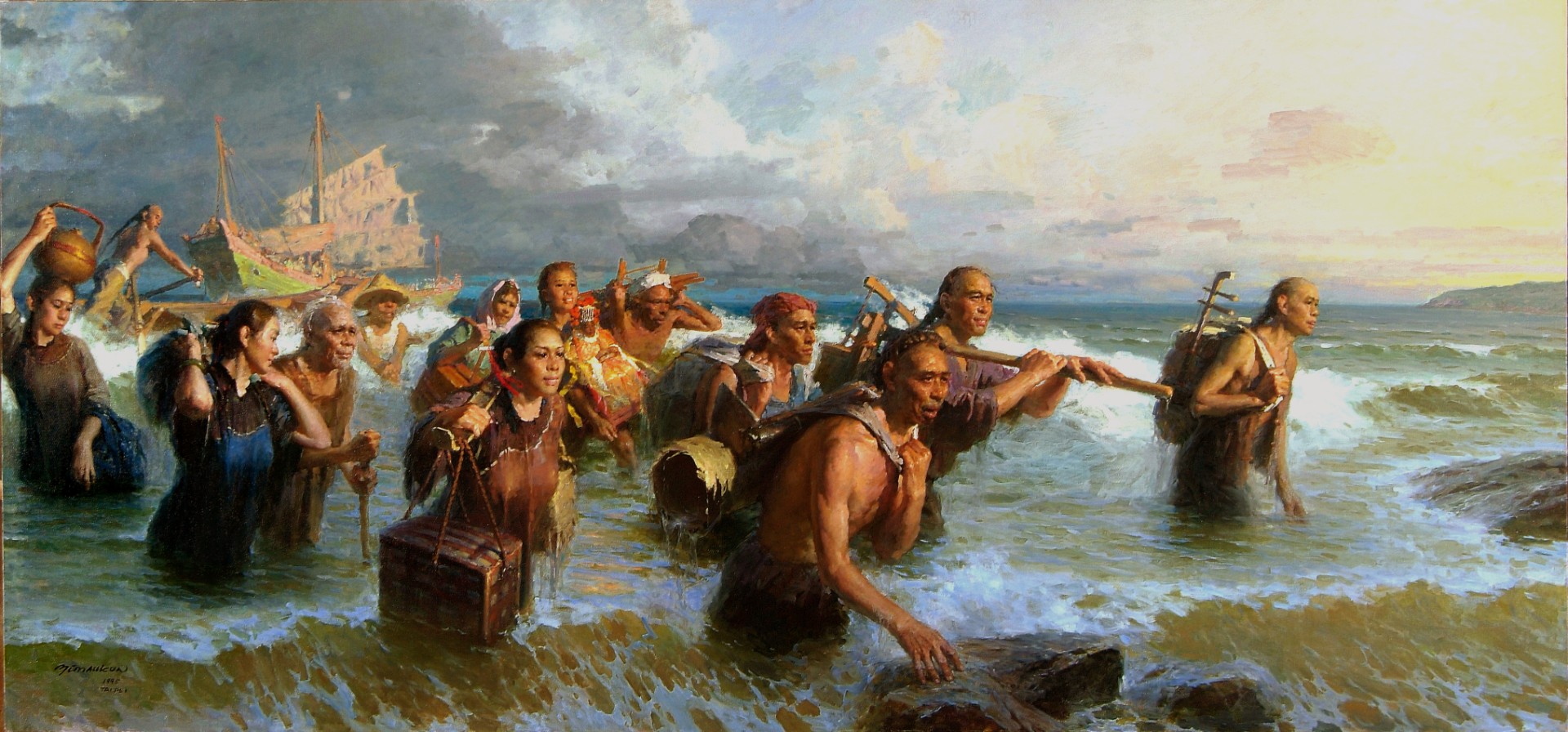
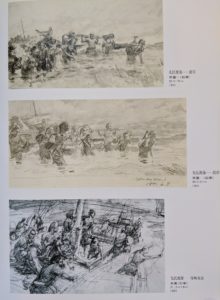
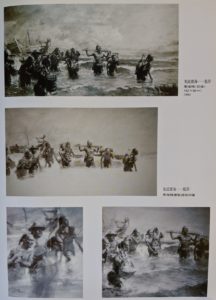
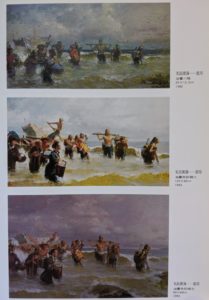
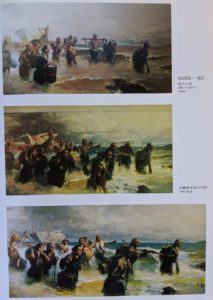

Unsaid is the fact that one must pick an enduring subject of interest since the artist must want to return again and again to the work over the years. That’s what intrigue me the most— the years of commitment to the narrative. That was a true enlightenment for me.
Thank you for this insight.